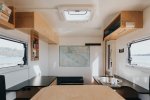Hi Folks,
1st time poster to this forum- I've read through what I can find on here about pros/cons of welding a frame for a camper directly to the frame of a toyota. For what it is worth, I just got back from a 5 month trip in Patagonia where I welded a steel frame onto a 92 4Runner and drove around without any issues.
I just bought an '02 F-250 7.3 long bed and am planning on taking the back off the truck and building a cheaper version of an earth roamer rig.
Here is my plan and questions for folks:
1. I was planning on using 1 inch square steel to build the frame of the camper and then using wood studs inside of the metal for added structural stability. I want to avoid using all steel for weight and issues installing the exterior fiberglass siding. Question: Do you see an issue with welding directly to the frame of the F-250? I am going to extend the length of the car to a 12 foot box- so will be adding an extra 4 feet off the end of the car. The frame is super solid (clearly) and the weigh of the cab all finished should be way under 1000 pounds.
2. For the exterior walls I am planning on using 1/4 plywood with EPS glued on the inside to give it some added structural rigidity. From there I was going to fiberglass the outside of the box.
Question: what weight cloth would you use for the side walls and roof? I am having a little trouble understanding the ideal finish for the fiberglass- gel coat vs wax coat. Can anyone make a quick recommendation?
3. The camper is basically a 6.5ft wide x 6.5 ft tall x 12ft long box. I want to keep the overcab profile as aerodynamic as possible (I understand the irony of the statement) I do not want to sleep over the cab- so it will just be storage space. The designs I have seen on most modern campers have a slight rise to the roof line to make it a bit tear drop shaped. Do you think this helps at all? When you look at the front of the truck I am trying to decide if the overcab portion should just be a flat upward sloped angle or a curve? Is there a difference for aerodynamics?
4. I am going to attach the overhang of the camper to the top of the cab of the truck. My plan was to use a rubber gasket and silicon to make this connection so that the camper doesn't actually sit on the roof of the truck, but prevents air flow and (hopefully) water from getting into the space between the truck and camper.
Question: Any brilliant ideas for how to make this seam work?
*Sorry for the lack of pictures for the concept. I can't draw to save my life...
Thanks for the input and looking forward to sharing build pics and lessons learned as I lay into this project...
1st time poster to this forum- I've read through what I can find on here about pros/cons of welding a frame for a camper directly to the frame of a toyota. For what it is worth, I just got back from a 5 month trip in Patagonia where I welded a steel frame onto a 92 4Runner and drove around without any issues.
I just bought an '02 F-250 7.3 long bed and am planning on taking the back off the truck and building a cheaper version of an earth roamer rig.
Here is my plan and questions for folks:
1. I was planning on using 1 inch square steel to build the frame of the camper and then using wood studs inside of the metal for added structural stability. I want to avoid using all steel for weight and issues installing the exterior fiberglass siding. Question: Do you see an issue with welding directly to the frame of the F-250? I am going to extend the length of the car to a 12 foot box- so will be adding an extra 4 feet off the end of the car. The frame is super solid (clearly) and the weigh of the cab all finished should be way under 1000 pounds.
2. For the exterior walls I am planning on using 1/4 plywood with EPS glued on the inside to give it some added structural rigidity. From there I was going to fiberglass the outside of the box.
Question: what weight cloth would you use for the side walls and roof? I am having a little trouble understanding the ideal finish for the fiberglass- gel coat vs wax coat. Can anyone make a quick recommendation?
3. The camper is basically a 6.5ft wide x 6.5 ft tall x 12ft long box. I want to keep the overcab profile as aerodynamic as possible (I understand the irony of the statement) I do not want to sleep over the cab- so it will just be storage space. The designs I have seen on most modern campers have a slight rise to the roof line to make it a bit tear drop shaped. Do you think this helps at all? When you look at the front of the truck I am trying to decide if the overcab portion should just be a flat upward sloped angle or a curve? Is there a difference for aerodynamics?
4. I am going to attach the overhang of the camper to the top of the cab of the truck. My plan was to use a rubber gasket and silicon to make this connection so that the camper doesn't actually sit on the roof of the truck, but prevents air flow and (hopefully) water from getting into the space between the truck and camper.
Question: Any brilliant ideas for how to make this seam work?
*Sorry for the lack of pictures for the concept. I can't draw to save my life...
Thanks for the input and looking forward to sharing build pics and lessons learned as I lay into this project...



